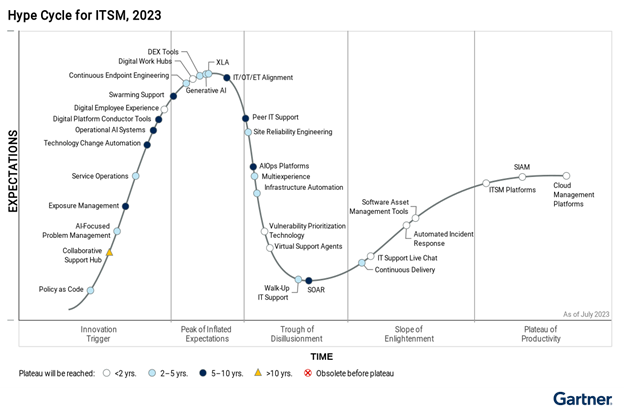The Gartner® Hype Cycle™ for ITSM, 2023* details the IT practices and transformational technologies that are hitting the “Peak of Inflated Expectations (e.g., IT/OT/ET alignment); those in the “Trough of Disillusionment (e.g., SOAR); and those that have reached the “Plateau of Productivity” (e.g., cloud management platforms).
What remains in the “Innovation Trigger” category once again? Service operations, or ServiceOps. Take a look:

What is ServiceOps?
In the report, Gartner defines ServiceOps as “The convergence of the infrastructure and application monitoring environments with the ITSM incident management practice to create a more effective and optimized mechanism for diagnosing and resolving incidents. The combination of the two environments with the context of AI can lead to a significant reduction in both the number and impact of incidents.”
Why is it important?
According to the report, “the ability to quickly diagnose and resolve incidents is critical for organizations as they develop and implement digital services. Intelligent automation can remove monitoring and service desk silos, creating the concept of service operations. This ensures that incident detection through monitoring can be better integrated with ITSM platforms, leading to incidents that can be more readily identified and resolved creating higher availability and more resilient services.”
What is the business impact?
In the report, Gartner explains the impact this way: “The convergence of ITSM and monitoring environments results in a more productive and seamless incident management practice. The contextual analysis of alerts resulting in anomaly detection and escalation can result in fewer incidents and improved mean time to resolve (MTTR), especially when integrated with the ITSM platform. Products and services are more available and less likely to suffer from poor performance or outages and disruption, costs are reduced, and overall productivity is improved.”
Gartner adds that there are several factors driving ServiceOps right now: “Business pressure for reliable and stable services drives the demand for incidents to be either eliminated before they can cause disruption or be diagnosed and resolved as quickly as possible.”
Advances in technology and ITSM are also helping drive ServiceOps. According to Gartner, other drivers include:
- The closer integration of monitoring and the service desk that creates a more seamless environment in which outages and disruptions can be more effectively managed.
- ITSM platforms featuring observability and correlation functions to identify incidents as part of the monitoring capabilities.
- ITSM platforms can now enrich events by applying the context of recent incidents and changes to impacted configuration items (CIs) to improve root-cause identification.
- The rise in the use of AI which enables the monitoring systems to swiftly correlate events and anomalies to present to technicians via the ITSM platform.
Obstacles to ServiceOps
According to the report, ServiceOps also faces obstacles. The report states: “AI-based monitoring services can take longer than expected to understand the context of the services, the traffic, and the environment creating delays in improving availability.”
Gartner explains that ServiceOps requires “Improved diagnostics and resolution times require time and effort to achieve due to dependencies including effective service mapping, the degree of automation and the quality of monitoring. This requires a concerted effort to achieve a holistic approach. Accurate service mapping and comprehensive, up-to-date configuration management databases are necessary to support end-to-end incident processes if enhanced availability and resilience is to be achieved,” and “automated responses need to be carefully chaperoned to ensure that their decisions match the use case.”
Gartner also explains, “Many monitoring and service desk teams operate in silos, making it difficult to create a seamless experience.”
Generative AI
This year, Gartner included generative AI in its report, noting the “interest in how AI underpins ITSM has gained momentum due to generative AI applications like ChatGPT.” The report categorizes generative AI as hitting the “Peak of Inflated Expectations,” as shown in the chart above. But Gartner anticipates it will reach a plateau in just two to five years.
What is Generative AI?
As Gartner defines it, “Generative AI technologies can generate new derived versions of content, strategies, designs and methods by learning from large repositories of original source content. Generative AI has profound business impacts, including on content discovery, creation, authenticity and regulations; automation of human work; and customer and employee experiences.”
Why is it important?
According to Gartner: “Generative AI exploration is accelerating, thanks to the popularity of Stable Diffusion, Midjourney, ChatGPT, and large language models. End-user organizations in most industries aggressively experiment with generative AI. Technology vendors from generative AI groups to prioritize delivery of generative-AI-enabled applications and tools. Numerous startups have emerged in 2023 to innovate with generative AI, and we expect this to grow. Some governments are evaluating the impacts of generative AI and preparing to introduce regulations.”
What is the business impact?
Gartner notes the business impact of generative AI in the report, explaining, “Most technology products and services will incorporate generative AI capabilities in the next 12 months, introducing conversational ways of creating and communicating with technologies, leading to their democratization. Generative AI will progress rapidly in industry verticals, scientific discovery, and technology commercialization.”
Among the drivers for generative AI, Gartner identifies: “Machine learning (ML) and natural language processing platforms are adding generative AI capabilities for reusability of generative models, making them accessible to AI teams.” Generative AI industry applications are growing, impacting creative work in marketing, design, music, and content. Generative AI is expected to disrupt software coding, and when “combined with development automation techniques, it can automate up to 30% of the programmers’ work,” according to Gartner.
Obstacles to generative AI
Generative AI poses many obstacles. Gartner states that “democratization of generative AI uncovers new ethical and societal concerns. Government regulations may hinder generative AI research.” The report adds that, “hallucinations, factual errors, bias, a black-box nature, and inexperience with a full AI lifecycle preclude the use of generative AI for critical use cases.”
Gartner also explains that the potential use of AI for nefarious purposes represents an obstacle, explaining, “Sadly, it will also become a security and societal threat when uses for nefarious purposes. Responsible AI, trust, and security will be necessary for the safe exploitation of generative AI.”
BMC’s approach to ServiceOps
BMC addressed ServiceOps when we combined our service management and operations management capabilities under one solution, the BMC Helix platform. Putting artificial intelligence (AI) and machine learning (ML) at the core of BMC Helix, we created a complete, integrated software-as-a-service (SaaS) digital transformation engine that converges ITSM and ITOM. BMC Helix modernizes processes and workflows for both service management and IT operations teams and empowers organizations to accelerate DevOps; leverage intelligence for faster, better decision-making; and strengthen collaboration.
We believe that ServiceOps removes organizational silos between service and operations management functions, opens new collaboration channels, elevates experiences, and boosts productivity for teams by:
- Unifying data and workflows throughout hybrid cloud environments, minimizing manual, repetitive processes, and increasing the speed toward desired business outcomes.
- Spending less time reactively responding to incidents and proactively resolving them before they impact the business through integrated, cross-platform AI/ML, intelligent automation, and predictive service management in concert with other BMC Helix solutions.
- Automating processes and reducing silos to foster collaboration across IT, lines of business, product teams, and customers.
BMC’s approach to Generative AI
BMC HelixGPT is our answer to the next level of efficiency that enterprise operations will require with near real-time processing of operational data from infrastructure, applications, and end users. We believe that generative AI can establish a complete view of reality using this data from disparate sources, while ticket, incident, and change data inform how human beings have been responding to issues native to the environment and the business. BMC HelixGPT integrates all of these traditionally siloed data sources to derive actionable insights for anomalies and autonomous resolutions for mundane issues.
We developed BMC HelixGPT to ensure that the insights provided are human-relatable and still specific to the enterprise, so answers are based on organizational expertise, hence the term “expert of your systems.” We constrain our GPT with a domain- and tenant-specific model that continuously learns resolutions from subject matter experts (SMEs) in the organization.
BMC is excited to be a part of this transformational time in IT management and operations technology with our ServiceOps and generative AI offerings, and we will continue to innovate and integrate them with our BMC Helix portfolio.
*Gartner, Hype Cycle for ITSM, 2023, By Siddharth Shetty, Chris Laske, 14 July 2023.
This graphic was published by Gartner, Inc. as part of a larger research document and should be evaluated in the context of the entire document.
GARTNER is a registered trademark and service mark of Gartner, Inc. and/or its affiliates in the U.S. and internationally, Hype Cycle is a registered trademark of Gartner, Inc. and/or its affiliates and is used herein with permission. All rights reserved.
Gartner does not endorse any vendor, product or service depicted in its research publications, and does not advise technology users to select only those vendors with the highest ratings or other designation. Gartner research publications consist of the opinions of Gartner’s research organization and should not be construed as statements of fact. Gartner disclaims all warranties, expressed or implied, with respect to this research, including any warranties of merchantability or fitness for a particular purpose.







